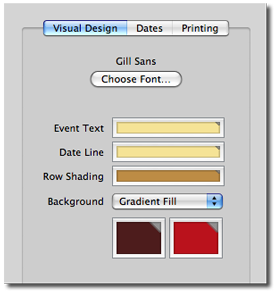About Color and Fonts
How to make your timeline look stunningly beautiful.

You can choose any combination of font and color to customize your timeline. The settings that control the graphical display of your timeline are found in the Visual Design tab of the Settings panel.
Fonts
There is one font face and size per timeline chart. This font will be used in the event display, row tick marks, and row titles.
The design of each font will help determine the layout of the timeline, so you may notice that the events move to new locations when a new font is chosen. For example, more compact fonts will result in a more compact timeline.
There are several ways to select a new font: Click the Choose Font button in the Visual Design tab, click the Font button in the toolbar, or select Show Fonts from the Format menu. You can also adjust the font size without opening the font panel by using the Command-plus and Command-minus shortcut keys.
Event Text
The color of event text may be set on a per-event basis. To change the color of an event, select the event and then change the color using the color well labeled “Event Text” in the Visual Design tab. New events will be assigned the same color as the most recently selected event.
Date Line
To adjust the color of the row foundation line, tick marks, and row title, use the Date Line color well.
Row Shading
To adjust the background color of the row foundation, use the color well labeled Row Shading. Note that it often works well for this color to be transparent or semi-transparent.
Background
There are several possible settings for the Background Color. First, you can select “None” using the Background popup menu if you want a transparent background for your timeline. This is useful if you wish to export your timeline as a PDF and then composite your chart over other graphical elements in a different application, such as Keynote.
You may also choose Color Fill or Gradient Fill to order to select one or two colors to display behind your chart. These are the most common background options.